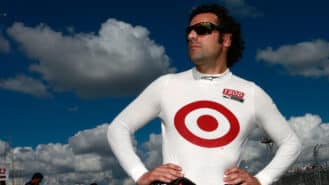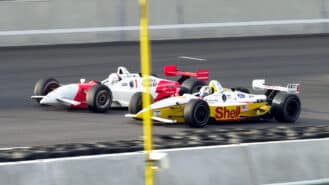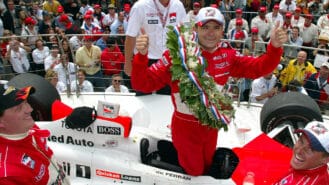 When Dario Franchitti first went to the Indianapolis 500, he tried to approach it like any other motor race. But as he admits during his lunch interview with Simon Taylor in the May issue of Motor Sport, he couldn’t help being affected by ‘The Brickyard’. The size and scale of the place, the buzz surrounding the town through the month of May, how much it mattered to everyone around him: he knew this was special, and for a driver with a rare passion for racing history and an obsession with Jim Clark, Dario couldn’t avoid the magical draw of America’s greatest race.
When Dario Franchitti first went to the Indianapolis 500, he tried to approach it like any other motor race. But as he admits during his lunch interview with Simon Taylor in the May issue of Motor Sport, he couldn’t help being affected by ‘The Brickyard’. The size and scale of the place, the buzz surrounding the town through the month of May, how much it mattered to everyone around him: he knew this was special, and for a driver with a rare passion for racing history and an obsession with Jim Clark, Dario couldn’t avoid the magical draw of America’s greatest race.
That it remains in 2011, despite the scars of the split that almost destroyed the sport of Indycars. The ‘500’ was the glue that kept single-seater oval racing intact in an era dominated by NASCAR. The race – the event – was quite simply too big to go down.
This May Indianapolis will celebrate the 100th anniversary of a yearly occasion that fired a nondescript Midwestern city into the consciousness of any true sports fan anywhere in the world. It is a landmark that we at Motor Sport felt compelled to celebrate – which is why we have dedicated a sizeable chunk of the May issue to the wonderful history of the race.
So why should a British magazine get so excited about an event in which 33 drivers only turn left around a four-corner rectangle for 500 miles? Read Robin Miller’s article on his own personal relationship with the Speedway to find out. The determination, strength and humour of the racing spirit is the oxygen that gives life to our magazine, and Robin’s piece is high on it! At the Speedway, it’s so strong you can taste it, as John Cooper, Colin Chapman, Jimmy Clark, Graham Hill, Jackie Stewart, Nigel Mansell, Dan Wheldon, Franchitti and many others from ‘over here’ found out when they travelled ‘over there’.
Britain’s relationship with the 500 has ebbed and flowed over the century, but it’s always existed. Take the Speedway’s great historian Donald Davidson: you wouldn’t know it speaking to him now, but he’s a Brit. But on his first visit to the Speedway in 1964, he knew he’d found his true home. As the locals found out, no one has more understanding and knowledge of the race, and he was the obvious choice to put a 100 years of racing history into context.
Now, that sounds like the subject of a doorstop-sized book, so how could we distil it into a magazine article? Donald thought long and hard. What he came up with – the greatest, most dramatic finishes in the 500’s history – does so beautifully. Even if you’re an Indy doubter, I’d urge you to read it.
The British theme continues via Ian Wagstaff, who has written a recent book on the subject. We’ve steered clear of the rear-engined revolution of the 1960s because so much has already been said, as any regular reader of Motor Sport will know. No, too obvious for us! So Ian tells the story of the second British invasion of Indianapolis that in its own way changed the shape of the race as much as the pioneering years of the mid-60s.
Add the interview with Dario and another with the Unsers – the first family of the 500 – and I hope you’ll find it does justice to 100 years of incredible speed and action.
Now, I know US oval racing is not everyone’s shot of bourbon. So as usual there is plenty more in the May issue to keep you reading for the month. Nigel Roebuck is typically forthright in his assessment of Formula 1’s recent entanglement in real-world politics, and as usual he puts the Bahrain debacle in context beautifully by reflecting on previous occasions when the sport has found itself on dodgy ethical ground. Then there’s his description of the Cuban Grand Prix – a race at which Juan Manuel Fangio found himself being kidnapped. Writing about it in 2011, it’s hard to imagine it actually took place. Fernando, count yourself lucky…
Nigel also sits down with Stirling Moss to revisit what many consider his greatest race, the 1961 Monaco Grand Prix – yes, another anniversary, this time just a mere half-century ago. We also print an edited version (God, he’d go mad at us for cutting his copy!) of Denis Jenkinson’s original race report for Motor Sport and reproduce some of his beautifully neat and detailed notes from the weekend when Moss beat the ‘Sharknose’ Ferraris.
Alan Henry talks to Ron Dennis about his formative years in team management, in Formula 2 during the early 1970s; Patrick Head recalls the breakthrough years of the Williams FW07; and Tiff Needell opens his personal scrapbooks to show us his collection of racing photos that he snapped from the spectator banks of the 1960s – when his love of the sport took hold.
And if that’s not enough, don’t miss our free supplement* on the Motor Sport Hall of Fame, in association with TAG Heuer, which took place in London during February. It seems like ages ago already. Before we know it, we’ll be heading back to the Roundhouse in 2012 for the next one…
*Available in the UK only

 When Dario Franchitti first went to the Indianapolis 500, he tried to approach it like any other motor race. But as he admits during his lunch interview with Simon Taylor in the May issue of Motor Sport, he couldn’t help being affected by ‘The Brickyard’. The size and scale of the place, the buzz surrounding the town through the month of May, how much it mattered to everyone around him: he knew this was special, and for a driver with a rare passion for racing history and an obsession with Jim Clark, Dario couldn’t avoid the magical draw of America’s greatest race.
When Dario Franchitti first went to the Indianapolis 500, he tried to approach it like any other motor race. But as he admits during his lunch interview with Simon Taylor in the May issue of Motor Sport, he couldn’t help being affected by ‘The Brickyard’. The size and scale of the place, the buzz surrounding the town through the month of May, how much it mattered to everyone around him: he knew this was special, and for a driver with a rare passion for racing history and an obsession with Jim Clark, Dario couldn’t avoid the magical draw of America’s greatest race.


